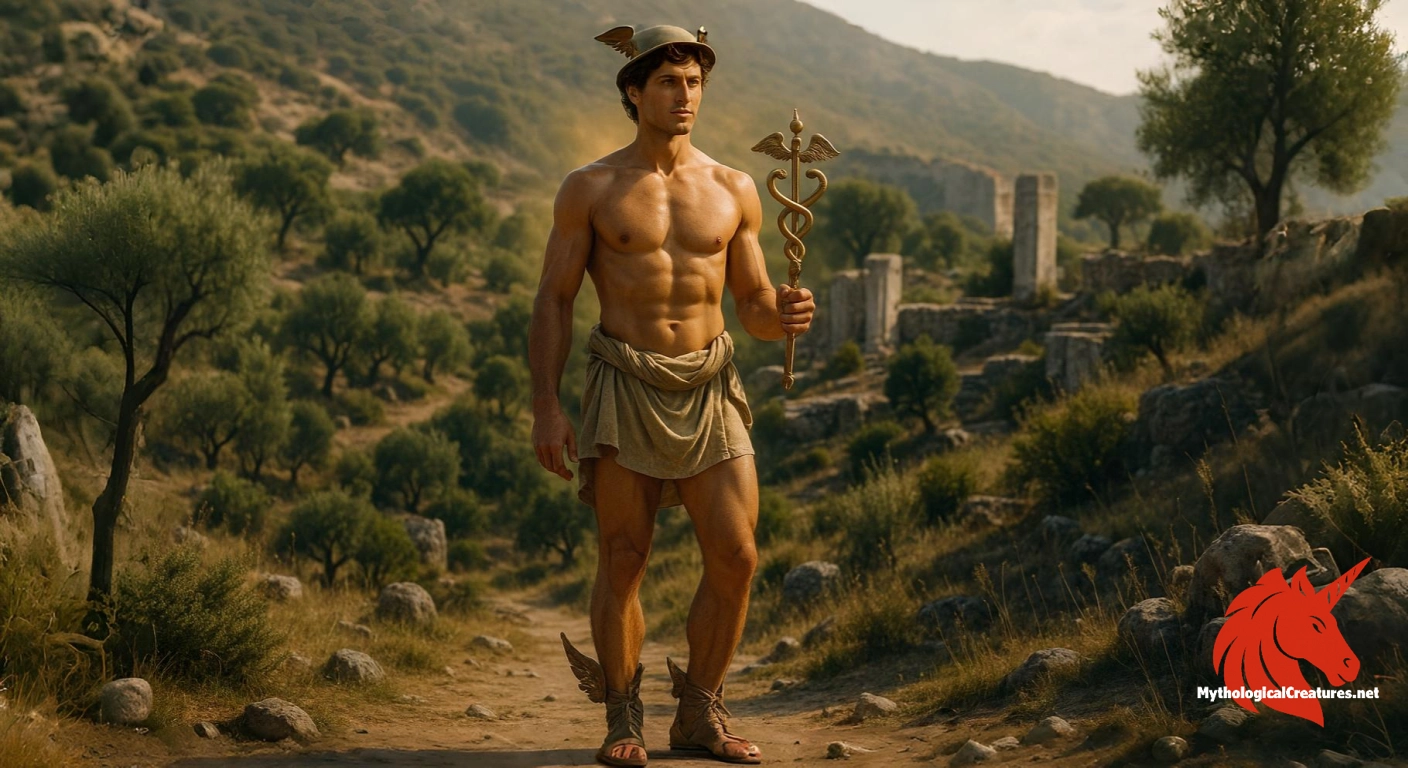Hermes: Hermes is an Olympian god renowned as the swift messenger and trickster in Greek mythology.

Hermes
Hermes - Hermes is a pivotal deity linking the divine and mortal realms and symbolising communication, commerce, and transformation.
Origins & First Encounters
Hermes occupies a unique position in the Greek pantheon, merging divine authority with a vibrant mortal charm. Born of Zeus and the Pleiad Maia, he was introduced into myth as a figure bridging human life and the realm of the gods. His early narratives are rich with episodes of wit and innovation, revealing a character both clever and resourceful. The swift, dynamic messenger earned admiration for his ability to move seamlessly between different worlds, a feat symbolised by his signature winged sandals. His role as a guide for souls on their journey to the afterlife further expands his character, underlying a deep connection to the mysteries of life and death. In various myths, he emerges not only as a herald but also as a guardian of travellers, merchants, and orators. Classical depictions emphasise his dual nature, combining the qualities of a trickster with those of a trusted guide. His presence in ceremonies and rituals across ancient Greece underscores his integral role in conveying messages and maintaining cosmic order. Hermes remains a timeless emblem of adaptability, reflecting both the ordinary and the extraordinary facets of human existence.
Source Texts & Tale Variants
Ancient texts provide a varied and layered portrayal of Hermes, capturing his multifaceted personality across different eras of Greek literature. The Homeric Hymn to Hermes offers one of the most celebrated narratives, recounting his ingenious exploits and early acts of mischief. Hesiod’s poetic compositions also reference his qualities, lending a mythopoetic dimension to his role within the divine order. Later compilations and mythographical works further elaborate on his interactions with other gods and his influential role as a guide and mediator. Classical dramatists and historians have woven additional strands into his character, emphasising the subtleties of his cunning and wisdom. Diverse story variants underscore his inventive spirit, notably in accounts of crafting the lyre and engaging in clever negotiations with other deities. Beyond literary sources, local legends preserved in regional cult practices have enriched his narrative with unique local motifs. The multiplicity of these sources illustrates how Hermes’ persona evolved, integrating aspects of trickery, commerce, and spiritual guidance. His continued depiction in various artistic mediums speaks to the adaptability and enduring appeal of his myth. This blend of accounts from formal texts and oral traditions has ensured that his legacy remains both dynamic and intricate.
Form & Powers
Visual representations of Hermes capture a youthful figure marked by dexterity and an effortless charm. His physical form is often portrayed as lean and athletic, reflecting the agility required for his swift journeys. Artists commonly depict him with a poised yet playful expression, suggesting both the depth of his wisdom and the lightness of his trickery. His most iconic attribute, the winged sandals, imbues him with an almost otherworldly speed and fluidity. In many depictions, his head is adorned with a winged helmet or a petasos, symbolising his role as a divine messenger. The caduceus, entwined with serpents, is regularly shown in his hand, representing negotiation and balance between conflicting forces. His attire is typically elegant and functional, designed for the rapid transit between the mortal realm and the divine. Despite the variety of artistic interpretations, recurring elements such as subtle grace and dynamic movement highlight the essence of his character. Each visual portrayal brings forth a balanced portrayal of strength, serenity, and sly ingenuity, making his figure both memorable and eternally resonant.
Regional Faces
Regional interpretations of Hermes reveal a fascinating tapestry of cultural adaptations that extend beyond mainland Greece. In some local traditions, he is revered explicitly as the patron of travellers and merchants, with small shrines and emblems dedicated to his protective role. His depiction in these communities often focuses on the practical benefits of his guidance, emphasising safe passage and reliable commerce. As his myth transcended Greek borders, the figure of Hermes was assimilated into Roman culture under the name Mercury, where his attributes were further refined. Variations in iconography across regions include subtle differences in the design of the winged sandals, the styling of his hat, and even the form of the caduceus. Some local legends have enhanced his trickster aspects, portraying him as a versatile deity capable of both benevolent guidance and cheeky mischief. Folklore in different parts of the Mediterranean has celebrated him in festivals and rituals that highlight local customs and values. Each geographical retelling adds a layer of nuance, merging classical attributes with indigenous symbolism. These diverse regional narratives serve as a testament to the widespread influence and malleability of his myth. Overall, the evolving local adaptations of Hermes underscore a universal appeal that spans varying cultural landscapes.
Cultural Parallels
Comparative analysis reveals that Hermes shares intriguing similarities with messenger deities across several cultural traditions. His Roman counterpart, Mercury, mirrors his role nearly identically, safeguarding commerce and communication while also embodying traits of a divine trickster. Beyond the classical world, echoes of Hermes’ dual nature appear in mythological figures such as the Norse god, known for similar clever and elusive traits. While variations exist in their iconography and narrative emphasis, the fundamental theme of a bridge between realms remains central to these deities. Some Eastern mythologies also accommodate deities who traverse the boundaries between worlds, reflecting universal human concerns with transition and travel. In many cases, these deities not only communicate messages but also harmonise chaotic elements in the human experience. The caduceus, as a symbol of balance and negotiation, serves as a visual link between Hermes and these analogous figures. Their shared attributes help to illustrate the common narrative techniques that ancient cultures employed to explain the ineffable dynamics of existence. This cross-cultural conversation among mythologies enriches our understanding of how diverse societies conceptualised divine intervention. Ultimately, the similarities and differences between Hermes and his counterparts illuminate a broader, interconnected mythological heritage.
Legacy & Modern Evolution
The enduring legacy of Hermes is visible in the seamless evolution of his character from antiquity to modern interpretations. His transformation into Mercury in Roman mythology allowed his attributes to resonate widely through the cultural landscape of Europe. Later, during the Renaissance, his image was revisited by artists and scholars who celebrated his quicksilver intellect and timeless dynamism. Contemporary portrayals in literature, film, and visual art continue to evoke his essence as a symbol of communication, mobility, and ingenuity. Modern esoteric traditions, particularly those linked with Hermeticism, have transformed his myth into a philosophy of inner wisdom and hidden knowledge. The adaptability inherent in his character means that every era reimagines him in ways that reflect its own aspirations and dilemmas. His influence is also evident in the commercial use of imagery related to speed and efficiency, often drawing on the winged sandals and caduceus as icons. As societies progress and reinterpret ancient symbols, Hermes remains a bridge between the mythic past and contemporary ideas. His narrative provides a rich source of inspiration for exploring themes of transformation, boundary-crossing, and the synthesis of opposites. In every retelling, the enduring spirit of Hermes invites us to embrace both the practical and the mystical dimensions of existence.
Interesting Fact
Hermes is distinguished by his ability to traverse multiple realms, a characteristic that not only makes him the divine messenger but also a symbol of transition and transformation in mythology.
Quick Creature Info
Origin:
Features:
Associations:
Our Mythic Legendary Rating:

Also Sometimes Known As:
Habitat:
Supernatural Powers:
Physical Attributes:
Abilities:
Behavior:
Weaknesses:
Lore:
Related Creatures, Tales or Lore
- MMercury
- HHermod
- IIris
References
Discover Another Mythical Legend You May Not Have Heard Of?
Uncover the mysteries of ancient folklore and expand your knowledge of legendary beings from cultures around the world.
Dare to Meet the Iubdan....
Mythical Disclaimer: The images and data on this site are derived from various historical and literary sources, but we have found that many myths often have multiple versions and interpretations across references, sometimes contradictory. As a result, these creature depictions are artistic interpretations—imaginative blends of folklore, legend, and a dash of AI guesswork. Because creature descriptions vary widely, our illustrations and accompanying information represent our best effort to honor mythology while bridging creative gaps. Enjoy these interpretations—just remember, we've done our best to respect the stories and validate available data, but in the realm of mythology, details often shift, imagination leads the way, and nothing is ever set in stone!
Curated by the Mythological Creatures Team (rev. May 2025)
